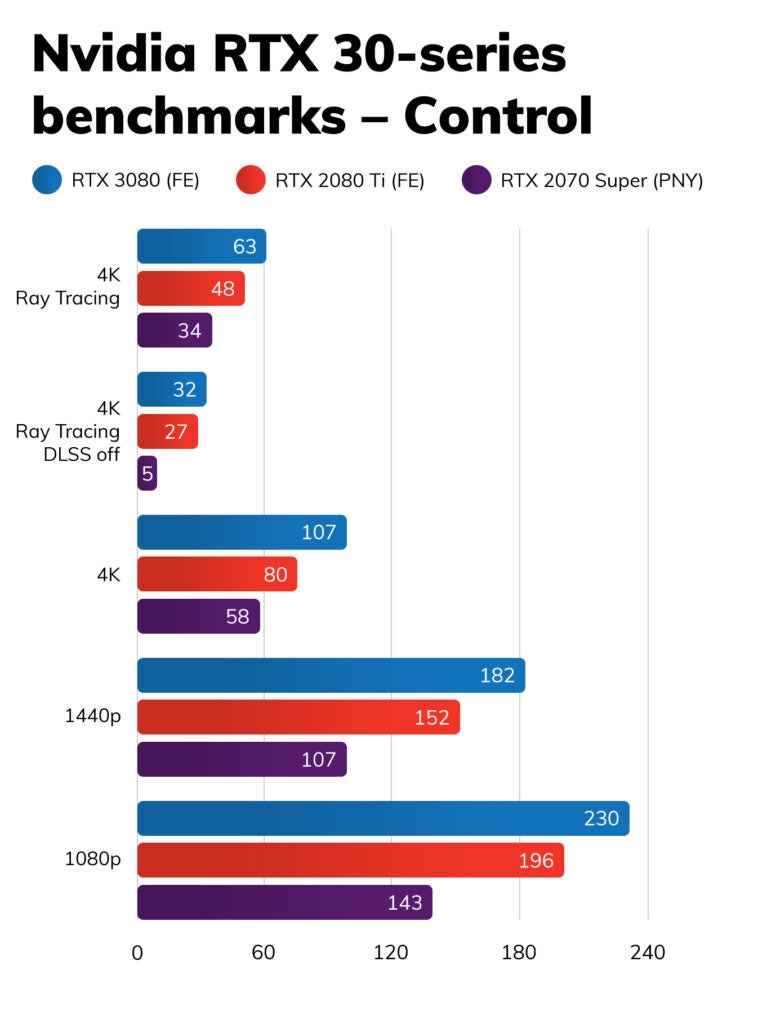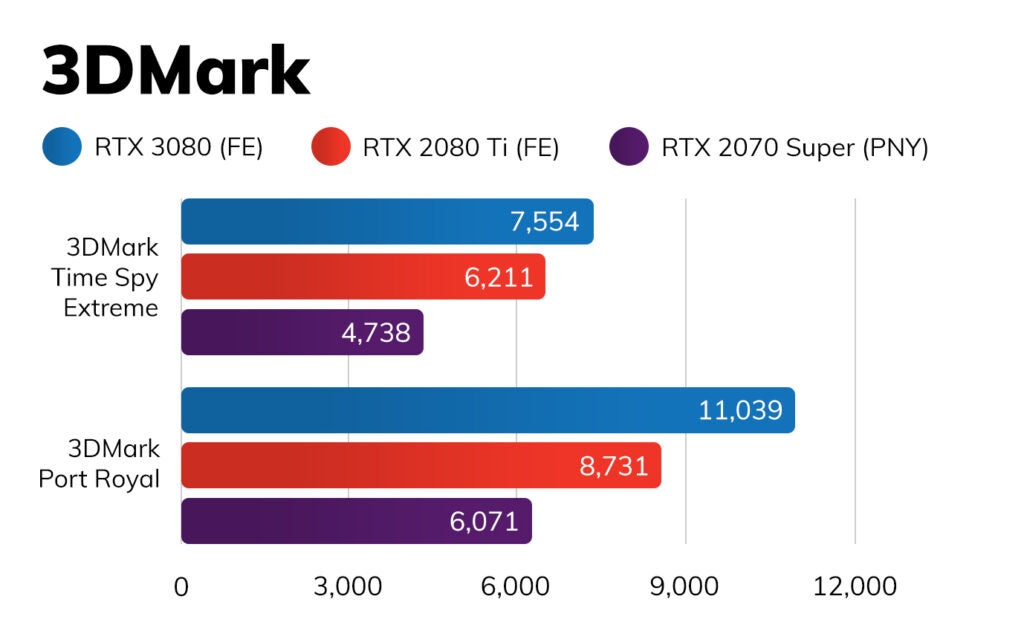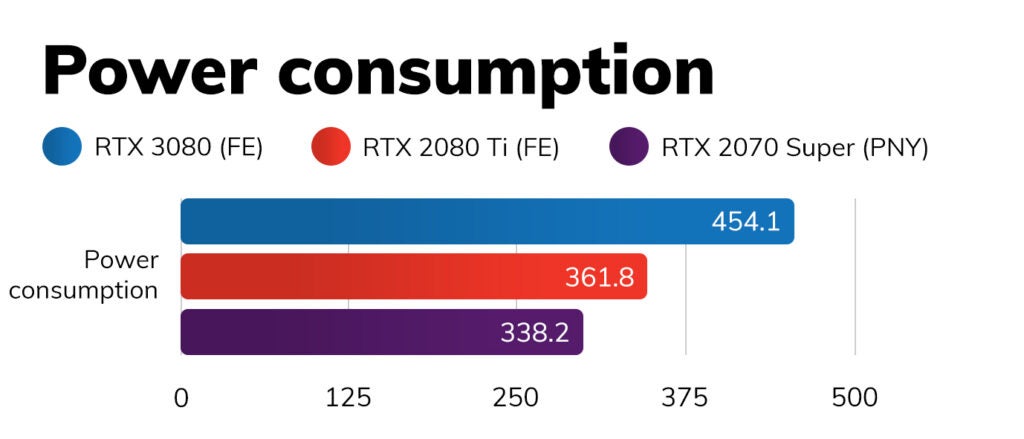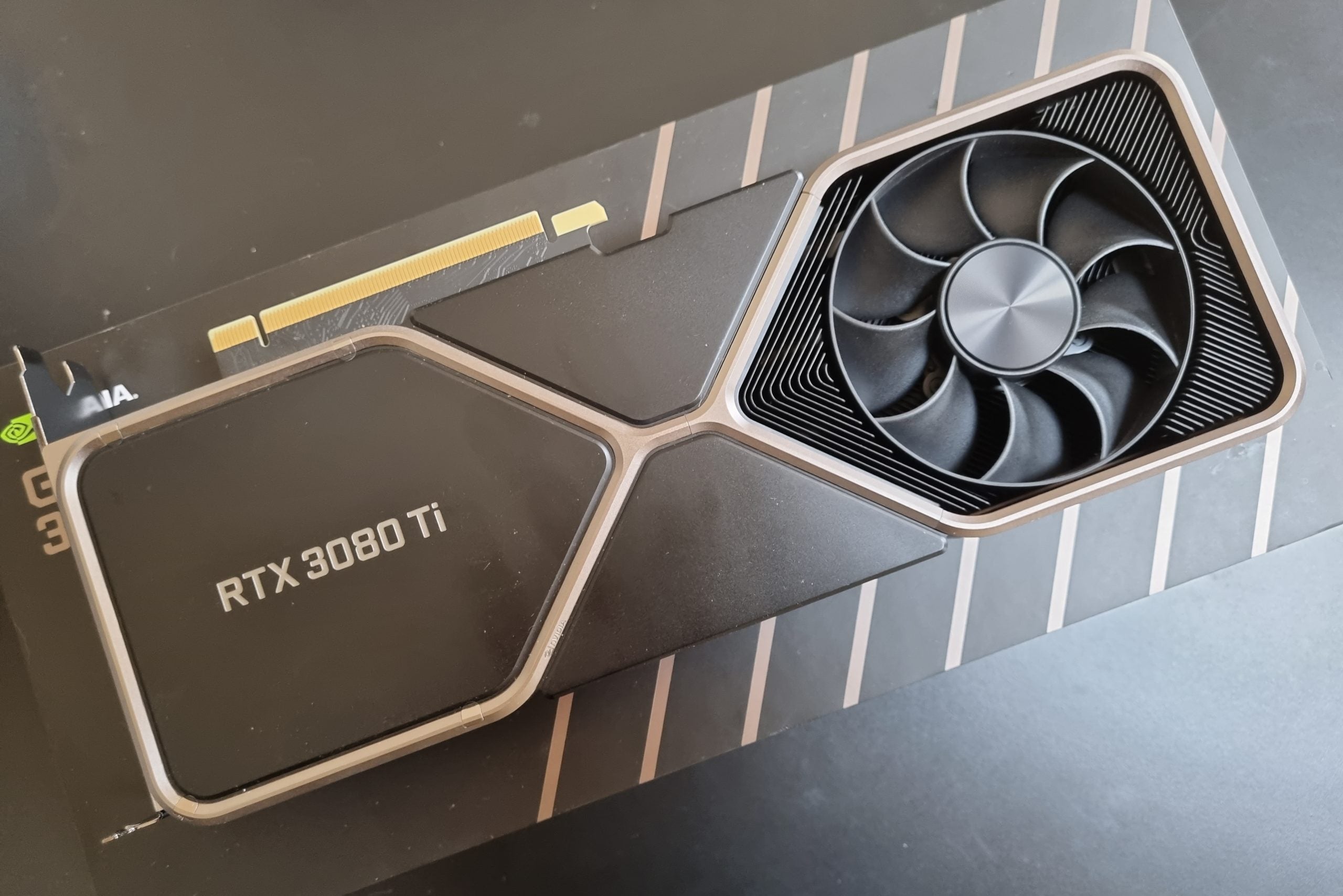Nvidia GeForce RTX 3080 Review
The RTX 3080 is the latest flagship GPU from Nvidia. Here's how it runs


Verdict
The Nvidia GeForce RTX 3080 is the first GPU that’s truly capable of 4K ray tracing, making it a must-have purchase for any hardcore gamer looking for top-notch performance.
Pros
- Excellent 4K performance
- Ray tracing is awesome
- Far cheaper than RTX 2080 Ti
- HDMI 2.1 support
Cons
- Very power hungry
- Not massively overclockable
Key Specifications
- Review Price: £649
- Originally reviewed: Sep 16, 2020
- 8704 CUDA cores
- 1.71GHz boost clock speed
- 10GB GDDR6X
- 320w TDP
- Ray tracing and DLSS ready
- HDMI 2.1, 3x DisplayPort 1.4a
- 2x PCIe 8-pin (adapter to 1x 12-pin included)
Editor’s Note 09/06/21: Nvidia has since released the RTX 3080 Ti. This is a new card that sits between the base 3080 and 3090. We recommend any reader check out our RTX 3080 Ti review as well as the below before making any purchase decision.
The Nvidia GeForce RTX 3080 is the latest flagship GPU from tech powerhouse Nvidia. It’s being marketed – at least at launch – as the ultimate option for anyone looking to enjoy uninterrupted 4K gaming at 60fps and above frame rates.
Having put the GPU thoroughly through its paces, we can confirm the RTX 3080 is currently the best option on the market for hardcore gamers and a clear step up on the firm’s previous RTX 2080, 2080 Super and 2080 Ti cards. Make no mistake, if you’re still on a 10-series, or lower end 20-series card and have cash spare, the RTX 3080 is the GPU to get.
The only downside is with the RTX 3090 now out and AMD Big Navi on the horizon, it’s time as ‘top dog’ could be short lived. Its top-notch performance also requires some serious power to run, meaning many gamers will have to look at getting a new PSU with it. For those with lower performance needs the Nvidia 3070 is also a very compelling option, offering top notch 1440p Ray Tracing performance coupled with a lower TDP and upfront cost.
If those caveats haven’t put you off, here’s what you need to know about the RTX 3080.
Specs and design
- Nvidia’s 2nd most powerful consumer GPU
- Ray tracing and DLSS is improved by Ampere
- HDMI 2.1 supports next-generation 8K TVs
The RTX 3080 is part of a wider 30-series family of cards that build on a number of the technologies debuted on the older Turing 20-series – which were the first GPUs to bring ray tracing and DLSS to mainstream PC gaming.
For those out of the know, ray tracing is a graphical technology set to appear on the PS5, Xbox Series X and Xbox Series S when they launch later this year. Ray tracing allows for more realistic lighting and shadow effects, while also adding key things like reflections to games.
DLSS is a nifty bit of tech that uses AI/machine learning to generate images that look like they’re being rendered at a higher resolution, consequently improving performance efficiency and frame-rate counts.
The RTX 3080 builds on this adding a few industry firsts and refinements from both a design and performance front.
On a design level, like all 30-series GPUs, the 3080 is built on a new 8nm process that lets Nvidia cram a whopping 28 billion transistors into the card. At a base level, this is a key factor that lets Nvidia improve the 3080’s specs and improve the card’s performance-per-watt power efficiency. You can see a breakdown of the 3080’s key specs and how it compares to its 30-series siblings and predecessors below.
| Nvidia CUDA Cores | Boost Clock Speed (GHz) | Memory | Graphics card power (W) | |
| RTX 3090 | 10,496 | 1.70 | 24GB GDDR6X | 350 |
| RTX 3080 | 8704 | 1.71 | 10GB GDDR6X | 320 |
| RTX 3070 | 5888 | 1.73 | 8GB GDDR6 | 220 |
| RTX 2080 Ti | 4352 | 1.64 | 11GB GDDR6 | 260 |
| RTX 2080 Super | 3072 | 1.82 | 8 GB GDDR6 | 250 |
| RTX 2070 | 2560 | 1.77 | 8 GB GDDR6 | 215 |
The specs demonstrate the 3080 as a significant upgrade on the 2080, featuring more CUDA cores (the soldiers that do most of the heavy lifting when gaming), a better clock speed (compared to the non-super models) and more VRAM. The only downside is, like every new generation from Nvidia, the TDP is a lot higher, making it a bit of a monster truck to run.
But there’s more than meets the eye here, as the more interesting changes are under the hood. Highlights include the use of new RT Cores, third-gen Tensor cores and Micron G6X video memory (VRAM). Nvidia has some pretty big performance claims about each of these new technologies. Specifically, the new RT Cores apparently offer 2x more throughput than the Turing versions seen on the 20-series, making them more efficient and better at ray tracing. The new Tensor cores apparently have more advanced AI powers which will make DLSS even better at upscaling and improving framerates.
The card’s also got a few other nifty features designed to help streamers and avid MOBA fans. The biggest of these are its Reflex Low Latency Technology. This is a cool bit of tech that’s designed to reduce latency in optimised games, like Apex Legends and Fortnite using AI wizardry.
The advanced AI powers also aim to help creatives featuring things like automated backgrounds and noise reduction features for streamers and 2x faster 3D rendering performance and 8K HDR video editing capabilities. Though for these you’ll need to download the Studio, not gaming, drivers for the card.
The only downside is that to make up for this Nvidia’s loaded the 3080 with a new 12-pin PCIe connector and set it with a fairly hefty 320w TDP. If paired with a top-end CPU, this means you’ll likely want to have at least a 750w PSU in your rig. Thankfully, if you already have one the 3080 comes with an adapter that makes it quick and easy to connect the card without having to upgrade.
The custom pin is one of many physical changes made to the Founders Edition (FE) card I tested. Unlike the 20 series cards, it has a Dual-Axial cooling system. This places the dual cooling fans on the top and bottom of the card’s left and right sides, with the main heat sink sitting between them. According to Nvidia the design offers 2x better cooling performance compared to the previous generation.
Around the back you’ll also see a new HDMI 2.1 input, which will let the GPUs in theory connect to next generation 8K TVs. The card’s support for the AV1 codec means it’ll also in theory use half the bandwidth when streaming 8K HDR content, though given how little of this type content there is at the moment, that’s at best futureproofing.

Benchmarks
- RTX 3080 capable of a 60+ FPS in 4K gaming
- DLSS pushes 4K performance over 100fps for Control
- Ray tracing sees a significant performance jump
The combination of factors make the Nvidia GeForce RTX 3080 a fairly compelling bit of kit at a technical level. Thankfully we also found there’s plenty of truth to the marketing spiel when we put the RTX 3080 through its paces in our test rig.
To test the RTX 3080 we used a test rig with the below specs and ran it through a series of synthetic benchmarks and real world tests. Every game we tested had their graphics settings maxed out. In each we found its 4K and ray tracing performance is a significant step up on the competing RTX 2080 Ti and RTX 2070 Super cards.
Test rig specs:
- Asus ROG STRIX Z370-E GAMING (LGA1151)
- Intel Core i9 9900KF
- 16GB DDR4 RAM
- Samsung SSD 860 EVO 500GB SATA SSD
- Corsair RM750X PSU
- MasterLiquid Pro 280 cooler
Editor’s Note: We didn’t benchmark the 3080 against every card on the market as we don’t have access to our full suite of review samples due to the ongoing Covid pandemic. We’ll update this review with the other cards’ scores when we can. We had to use a PNY 2070 Super, not FE, during testing for the same reason.

Control is one of the best games to show off ray tracing and DLSS. It features advanced physics and numerous scenes rife with demanding reflective environments and lighting effects that really put a GPU through its paces.
The game doesn’t have an in-built benchmark so we took an average FPS count running through an office area full of reflective surfaces, mixed lighting and moving NPCs. Here the 3080’s performance was a marked step up on the RTX 2080 Ti and 2070 Super, with the RTX 3080 being the only of the three to offer 4K ray tracing at 60fps. DLSS performance was also solid, though Control limits the rendering resolution when running.

Battlefield V is a sprawling, large scale, multiplayer game fill of numerous characters, demanding physics and high quality textures. It’s also one of the only popular multiplayer platforms to support ray tracing, making it a great test to see how GPUs will handle big-battle multiplayer, triple-A games.
It doesn’t have an internal benchmark so we tested the cards by running them through a demanding section of the Nordlys War Story. The scene is full of reflective ice and lakes, mirrors and enemy soldiers. Here again we saw big gains in frame rate running the RTX 3080, with it once again being close to a third faster than the RTX 2080 Ti with ray tracing active.

Borderlands 3 is a stylised open-world shooter that expects a lot from your GPU. It’s optimised for AMD cards so it doesn’t have ray tracing or DLSS, but it’s still a good metric to gauge how a card will handle most modern triple-A titles.
Running the three cards through its internal benchmark we once again saw sizable gains, particularly in 4K with the RTX 3080, though not to the point it consistently ran at over 60fps.

Doom Eternal is a prime example of a top-end, triple-A game that’s been properly optimised. It’s a beautiful looking game that isn’t as taxing on your GPU or CPU as you’d expect. It’s also one of a growing number of titles to force you to run on the Vulkan API, making it a great metric for how modern, non-openGL titles will run on a GPU. However, it doesn’t have an internal benchmark or support for ray tracing and DLSS.
We tested the graphics cards by checking the average frame rate after running through the opening section of the game’s first level. It includes numerous particle effects, moving NPCs and advanced physics.
Here every card performed well, though once again the RTX 3080 nailed 4K performance, hitting around 160fps.

The Division 2 is a popular open world shooter that follows the same loot model as Destiny. It doesn’t have the most advanced graphics but is a good metric to test how most modern massive multiplayer titles will run on a graphics card. The internal benchmark simulates a series of complex animations and particle effects during a heated city battle.
Here all the cards performed excellently, though once again the RTX 3080 was the only one of the three to consistently run the benchmark at frame rates above 60fps in 4K. .

Horizon: Zero Dawn is a beautiful, but not terribly well optimised game that was originally released as a PlayStation exclusive. It features beautiful, but demanding graphics that tax even the most powerful of graphics cards. It’s a good metric for how a card will handle difficult games as a result, despite not featuring ray tracing or DLSS support.
Running the three Nvidia cards through the game’s internal benchmark, which takes you through the 3080 once again commanded a respectable 50fps lead on its predecessor, cementing its place as the current king/queen of 4K gaming.

3DMark’s Time Spy Extreme is a synthetic benchmark designed to test a card’s Direct X 12, 4K performance. It’s one of the most demanding gaming benchmarks on the market and a good general metric of a GPU’s performance. The RTX 3080 scored roughly 18% higher than the RTX 2080 Ti.
3DMark’s Port Royale is a relatively recent benchmark designed to synthetically gauge a graphics card’s ray tracing performance. The RTX 3080 commanded a 2000 point lead on the RTX 2080 Ti, which is in line with our real-world gaming tests.
Overclocking, heat and power consumption
- The RTX 3080 saw a full system 454.1w peak power draw
- Doesn’t leave a lot of room for overclocking
The performance figures paint a clear picture, showing the RTX 3080 to offer at least 20-40% performance games in most areas compared to the RTX 2080 Ti. The only drawback is that, despite being more efficient on a per-watt basis, the card still demands significantly more power than its predecessor.
Checking consumption while running the 3DMark Time Spy Extreme benchmark I detected a massive 454.1w peak draw (full system). That’s nearly 90w more than the RTX 2080 Ti, and a sizable chunk of your PSU’s power.

The card tells a similar story with overclocking. Like the RTX 2080 and RTX 2080 Ti before it, the RTX 3080 doesn’t leave a lot of room for overclocking. Doing a rough and ready overclock using MSI Afterburner while looping the Unigine Heaven benchmark I was only able to get a stable 220Mhz core and 120Mhz memory overclock. After this the system began regularly crashing.
Thankfully thermal performance is solid, with the card running at a stable 70 degrees when being stress tested in Time Spy Extreme.

You should buy if…
- You want 4K performance at frame rates over 60fps
The Nvidia RTX 3080 is a ‘shut up and take my money’ purchase if you want a graphics card that excels at 4K gaming.
- You fancy ray tracing support
The RTX 3090’s biggest advantage over AMD GPUs is its more efficient ray tracing performance, while DLSS helps to offset the performance loss caused by the advanced light-rendering technology.
- You want a future-proofed graphics card
The Nvidia RTX 3080 has all the features required to be useful for the long-term, including HDMI 2.1 support for future monitors and TVs.
You shouldn’t buy if…
- You’re happy to stick to Full HD gaming
The Nvidia RTX 3080 is overkill if you’re yet to own a 4K display. The RTX 3060 Ti is a far better value option for 1080p gaming.
- You already own an RTX 2080 Ti graphics card
The RTX 3080’s performance gains aren’t quite high enough for us to recommend to people who have already shelled out for an RTX 2080 Ti upgrade.
- You don’t own a high-end PSU
It’s worth checking on your PSU wattage before hitting checkout, as there’s a chance you may need an upgrade in order to accommodate the monstrously powerful RTX 3080.
FAQs
The Nvidia GeForce RTX 3080 is a high-end graphics card capable of a 4K gaming performance, while supporting features such as DLSS and ray tracing.
Yes, the Nvidia GeForce RTX 3080 is a high-end graphics card. Only the RTX 3090 is more powerful in Nvidia’s gaming graphics card range.
Specs
Jargon buster
GPU
The graphics processing unit is designed to render graphics, which is particularly important for gaming, creating 3D models and editing video.
PSU
The ‘power supply unit’ converts mains AC to low-voltage regulated DC power for the internal components of a computer.
Ray Tracing
Advanced light-rendering technology that allows for more realistic lighting and shadow effects within in-game worlds.
DLSS
Deep learning super sampling is Nvidia’s image upscaling technology which can improve a game’s framerate without reducing the quality of the visuals.
Turing
Nvidia’s GPU architecture for 20-Series graphics cards
Ampere
Nvidia’s GPU architecture for 30-Series graphics cards
Nvidia Reflex
Technology designed to reduce latency in optimised games, like Apex Legends and Fortnite, using AI wizardry.
FPS
‘Framerate per second’ indicates how many images are shown within one second. The higher this figure, the smoother in-game motion will appear. Powerful discrete GPUs are far more likely to offer higher framerates compared to integrated graphics housed inside processors.




